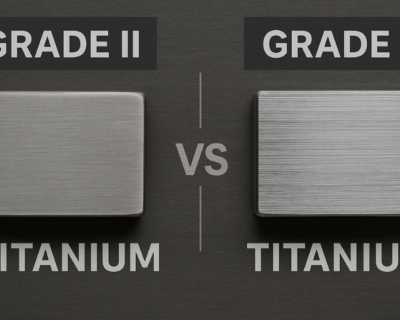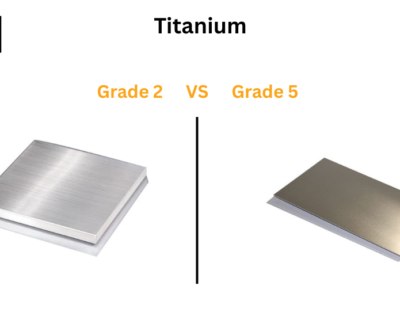Blogs

Titanium vs Steel: Which Metal is Right for Your Application?
The Metal They Tried to Hide in Plain Sight
When comparing Titanium vs Steel, you may be thinking Steel is everything—strong, reliable, cheap.
From constructing buildings. Your cars. Your railways. Even your cutlery.
But there’s another metal. One that is rarely talked about.
It doesn’t rust. It’s nearly half the weight. It survives inside the human body.
And it’s been flying in spacecrafts and cruising through oceans for decades.
Titanium. The secret metal of elite industries.
Why don’t we use it more? Why does it cost so much?
And is it really better than Steel?
This isn’t just a comparison. It’s a metallic mystery unraveled.
Titanium (UNS R50400) vs Steel (UNS G10200):
A tale of innovation, longevity, and the surprising truth about what your products are really made of.
Chemical Composition
| Property | Titanium (UNS R50400) | Steel (UNS G10200 – Carbon Steel) |
| Main Element | Titanium (~99.5%) | Iron (~98%) |
| Additives | Oxygen, Nitrogen, Carbon | Carbon (up to 1.0%), Manganese, Phosphorus, Sulphur |
| Density | ~4.5 g/cm³ | ~7.8 g/cm³ |
Key takeaway: Titanium is 40–45% lighter than steel—without compromising strength.
Technical Specifications
| Feature | Titanium (Grade 2 – R50400) | Carbon Steel (G10200) |
| Density | 4.51 g/cm³ | 7.87 g/cm³ |
| Tensile Strength | 344 MPa | 440–550 MPa |
| Yield Strength | 275 MPa | ~250 MPa |
| Melting Point | 1668°C | ~1425–1540°C |
| Corrosion Resistance | Excellent | Moderate to Poor |
| Modulus of Elasticity | 105 GPa | 200 GPa |
In-Depth Comparison: Titanium vs Steel
Titanium and steel have distinct properties.
Steel is generally stronger and more readily available, while titanium is lighter, more corrosion-resistant, and biocompatible. Titanium also has a higher strength-to-weight ratio, whereas steel is more affordable and easier to work with.
Strength
- Steel: Offers higher overall tensile and yield strength. Alloy steels can exceed Titanium’s raw strength.
- Titanium: Has a superior strength-to-weight ratio, making it ideal for applications where weight savings are critical.
Weight
- Titanium: Lightweight (4.5 g/cm³), reducing load in aerospace and automotive sectors.
- Steel: Denser and heavier (7.8 g/cm³), better for structural stability in buildings and machines.
Corrosion Resistance
- Titanium: Exceptionally resistant—survives seawater, acids, and harsh chemicals thanks to its protective oxide layer.
- Steel: Corrosion-prone unless coated or alloyed. Stainless steel offers better resistance but still below Titanium.
Biocompatibility
- Titanium: Safe inside the human body—used for implants, prosthetics, and surgical tools.
- Steel: Less compatible with human tissue; often avoided in medical-grade implants.
Cost
- Steel: Widely available, low-cost, easier to source and fabricate.
- Titanium: More expensive due to its rarity and complex extraction and machining processes.
Machinability & Weldability
- Steel: Easier to machine and weld using conventional methods.
- Titanium: Challenging to machine due to work hardening and low elasticity; welding requires specialized equipment.
Other Considerations
- Temperature Resistance: Titanium handles higher temperatures better than most steels.
- Fatigue Resistance: Titanium offers superior resistance in high-cyclic applications like turbines or moving implants.
Applications: Where They Shine
Titanium
- Aerospace – Jet engines, airframes, spacecraft.
- Medical Implants – Hip joints, dental screws, surgical tools.
- Automotive (High-Performance) – Race car components.
- Marine – Submarines, offshore rigs, propellers.
- Chemical Processing – Piping and equipment handling corrosive substances.
Steel
- Construction – Bridges, buildings, frameworks.
- Automotive – Car bodies, chassis, structural parts.
- Machinery – Tools, gears, industrial parts.
- Pipelines – Oil, gas, and water transmission.
- Home Appliances – Refrigerators, cookware, washing machines.
Shapes Available
Titanium:
- Rods, Plates, Sheets, Tubes, Bars, Wires, Forgings
Steel:
- Billets, I-beams, Rebar, Channels, Angles, Pipes, Coils
Properties: The Good, the Bad, and the Brilliant
| Property | Titanium | Steel |
| Weight | Lightweight | Heavy |
| Corrosion Resistance | Outstanding | Needs coatings |
| Weldability | Moderate | Excellent |
| Machinability | Difficult (gums up tools) | Good |
| Biocompatibility | Excellent | Poor |
| Cost | Expensive | Economical |
Standards
Titanium (UNS R50400)
- ASTM B348 (Rods & Bars)
- ASTM B265 (Plates, Sheets)
- ASTM F67 (Medical Grade)
- ISO 5832-2
Steel (UNS G10200)
- ASTM A36 (Structural Steel)
- ASTM A513 (Tubing)
- ASTM A106 (Pipes)
- SAE J403
Environmental Impact
While steel is recyclable, its high wear-and-tear rates lead to frequent replacements, creating more waste and higher energy usage for reprocessing.
Titanium, though costly upfront, lasts longer—especially in corrosive or high-stress environments. That means fewer replacements, less waste, and a lower carbon footprint over the product’s lifecycle.
Choosing Titanium is a strategic move toward sustainable engineering.
Conclusion: Titanium vs Steel – Choose with Purpose
Titanium (UNS R50400) and Steel (UNS G10200) each have their place in engineering.
- Steel is cost-effective, strong, and perfect for large-scale, everyday applications.
- Titanium offers superior corrosion resistance, lighter weight, and a longer lifecycle—ideal for high-performance and critical environments.
While Titanium comes at a higher upfront cost, its durability, efficiency, and environmental benefits often make it the smarter long-term choice.
So, when choosing between Titanium vs Steel, consider not just the budget—but the performance, longevity, and impact your material choice brings.
Reach out to Domadia’s team for recommendations or any sort of help.
Visit our website: Domadia.com
Email: sales@domadia.com
Call/WhatsApp: +91-9594066275
Follow us on LinkedIn: https://www.linkedin.com/in/kairav
Talk to: Er.Pankaj Domadia | Kairav Domadia | Aadil Domadia | Pragati Sanap | Pooja N N | Shivani Kanojia




